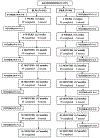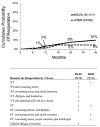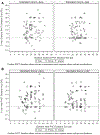A Randomized Trial Comparing Bilateral Lateral Rectus Recession versus Unilateral Recess and Resect for Basic-Type Intermittent Exotropia
- PMID: 30189281
- PMCID: PMC6348023
- DOI: 10.1016/j.ophtha.2018.08.034
A Randomized Trial Comparing Bilateral Lateral Rectus Recession versus Unilateral Recess and Resect for Basic-Type Intermittent Exotropia
Erratum in
-
Corrigendum.Ophthalmology. 2020 Nov;127(11):1590. doi: 10.1016/j.ophtha.2020.07.041. Ophthalmology. 2020. PMID: 33097115 No abstract available.
Abstract
Purpose: To compare long-term outcomes after bilateral lateral rectus recession (BLRc) or unilateral lateral rectus recession combined with medial rectus resection in the same eye (R&R) for primary treatment of childhood intermittent exotropia (IXT).
Design: Multicenter, randomized clinical trial.
Participants: One hundred ninety-seven children 3 to younger than 11 years of age with basic-type IXT, a largest deviation by prism and alternate cover test at any distance of 15 to 40 prism diopters (PD), and near stereoacuity of at least 400 seconds of arc.
Methods: Random assignment to BLRc or R&R and masked examinations conducted every 6 months after surgery for 3 years.
Main outcome measures: Proportion of participants meeting suboptimal surgical outcome by 3 years, defined as: (1) exotropia of 10 PD or more at distance or near using simultaneous prism and cover test (SPCT); or (2) constant esotropia of 6 PD or more at distance or near using SPCT; (3) loss of 2 octaves or more of stereoacuity from baseline, at any masked examination; or (4) reoperation without meeting any of these criteria.
Results: Cumulative probability of suboptimal surgical outcome by 3 years was 46% (43/101) in the BLRc group versus 37% (33/96) in the R&R group (treatment group difference of BLRc minus R&R, 9%; 95% confidence interval [CI], -6% to 23%). Reoperation by 3 years occurred in 9 participants (10%) in the BLRc group (8 of 9 met suboptimal surgical outcome criteria) and in 4 participants (5%) in the R&R group (3 of 4 met suboptimal surgical outcome criteria; treatment group difference of BLRc minus R&R, 5%; 95% CI, -2% to 13%). Among participants completing the 3-year visit, 29% (25 of 86) in the BLRc group and 17% (13 of 77) in the R&R group underwent reoperation or met suboptimal surgical outcome criteria at 3 years (treatment group difference of BLRc minus R&R, 12%; 95% CI, -1% to 25%).
Conclusions: We did not find a statistically significant difference in suboptimal surgical outcome by 3 years between children with IXT treated with BLRc compared with those treated with R&R. Based on these findings, we are unable to recommend one surgical approach over the other for childhood IXT.
Copyright © 2018 American Academy of Ophthalmology. Published by Elsevier Inc. All rights reserved.
Conflict of interest statement
Figures




Comment in
-
Bilateral Lateral Rectus Recession vs. Unilateral Recess-Resect for Intermittent Exotropia.Ophthalmology. 2019 Feb;126(2):318-319. doi: 10.1016/j.ophtha.2018.09.009. Ophthalmology. 2019. PMID: 30683181 No abstract available.
References
-
- Govindan M, Mohney BG, Diehl NN, Burke JP. Incidence and types of childhood exotropia: A population-based study. Ophthalmology 2005;112(1):104–8. - PubMed
-
- Paysse EA, Steele EA, McCreery KM, et al. Age of the emergence of negative attitudes toward strabismus. J AAPOS 2001;5(6):361–6. - PubMed
-
- von Noorden GK, Campos EC. Exodeviations In: Lampert R, Cox K, Burke D, eds. Binocular Vision and Ocular Motility: Theory and Management of Strabismus. St. Louis CV Mosby, 2002.
-
- Exotropia Wright K.. In: Wright KW, ed. Pediatric Ophthalmology and Strabismus. St Louis: Mosby Year Book, 1995.
Publication types
MeSH terms
Grants and funding
LinkOut - more resources
Full Text Sources
Other Literature Sources
Medical
Miscellaneous

